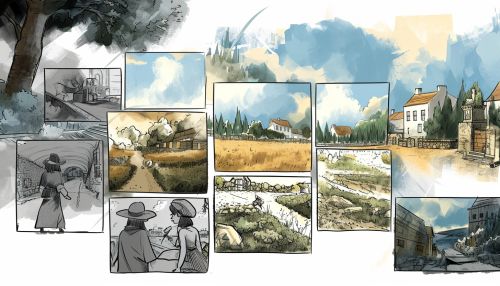Digital Storyboarding
Overview
Digital Storyboarding is a process that involves creating a series of illustrations or images displayed in sequence for the purpose of pre-visualizing a motion picture, animation, motion graphic, or interactive media sequence. This digital process has become an integral part of the production process in many types of media including film, television, and animation.
History
The concept of storyboarding originated in the film industry, with early practitioners such as Walt Disney and Alfred Hitchcock. The transition from traditional storyboarding to digital storyboarding began in the late 20th century with the advent of more sophisticated computer graphics technology. Today, digital storyboarding is widely used in the film and television industry, as well as in fields like advertising, game design, and software development.
Process
The process of digital storyboarding starts with the creation of a script or a concept. The storyboard artist then translates this script into a series of panels, each representing a specific moment or action. These panels are often accompanied by text descriptions or dialogue. The artist may use a variety of digital tools, including graphics software and drawing tablets, to create the storyboard.
Tools and Software
There are many digital tools and software available for creating storyboards. Some of the most popular include Adobe Photoshop, Illustrator, and Storyboard Pro. These tools allow artists to easily create, edit, and rearrange panels, as well as add text and other elements. Many of these tools also offer features like layering, zooming, and the ability to import images.
Advantages
Digital storyboarding offers several advantages over traditional methods. It allows for easier editing and revisions, as changes can be made directly on the computer without the need to redraw entire panels. Digital storyboards can also be shared and collaborated on more easily, as they can be sent electronically and viewed on any device with a screen. Additionally, digital storyboarding allows for more detailed and complex visuals, as artists can use the full range of digital tools and effects at their disposal.
Disadvantages
Despite its many advantages, digital storyboarding also has some potential disadvantages. Some artists find that working digitally can be less intuitive than working with physical media, and it can take time to learn how to use digital tools effectively. There is also the risk of technical issues, such as software crashes or file corruption, which can disrupt the storyboarding process.
Applications
Digital storyboarding is used in a wide range of industries and fields. In the film and television industry, it is used to plan out scenes and sequences before shooting begins. In animation, it is used to visualize the action and timing of each scene. In advertising, it is used to plan out commercials and other promotional materials. In game design, it is used to plan out game levels and cutscenes. And in software development, it is used to visualize the user interface and flow of an application.


